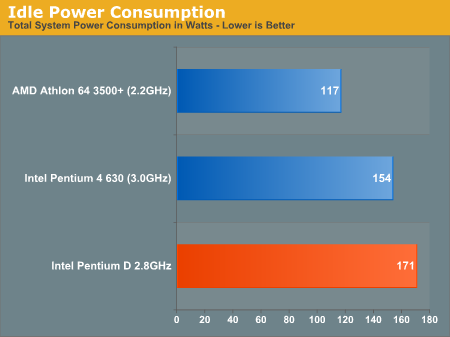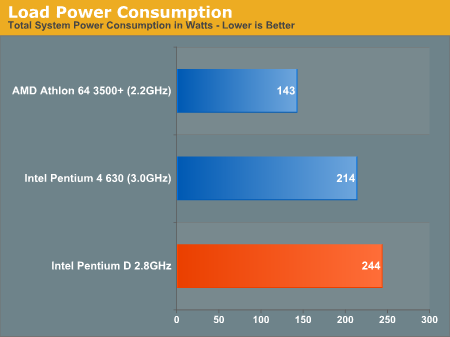Intel Dual Core Performance Preview Part II: A Deeper Look
by Anand Lal Shimpi on April 6, 2005 12:23 PM EST- Posted in
- CPUs
I'll admit, dual core has me excited for many of the reasons outlined in Part I. A big part is that personally, I've been using multiprocessor systems in my main computer for years. I've always appreciated the benefits of multiprocessor platforms, but recommending one for a desktop user has never been really feasible. Even the cheapest 2P workstation motherboards were at least twice the price of a desktop motherboard, not to mention the cost of the CPUs. The mass market had a short affair with multiprocessing in the days of the ABIT BP6 and the Celeron 300A, but in the grand scheme of things, that was barely a blip on the radar. Now, for the first time, both AMD and Intel are ready to bring the type of robustness of multiprocessor platforms to the desktop with their dual core offerings.
Part I focused on what dual core can offer, but now it's time for a much more practical look. We've never recommended Intel's Extreme Edition line of processors nor AMD's FX series, both supposedly marketed to gamers, but not purchased by any of our gaming readers. The processors that we recommend are usually much better values for the price, and thus, today's comparison isn't based around the most expensive dual core offerings, but rather the cheapest.
A point we made in the first article was that Intel's pricing strategy for dual core is extremely aggressive, with the cheapest 2.8GHz Pentium D soon to be introduced at $241. The problem is that at only 2.8GHz, the Pentium D won't have the strongest single threaded performance, which puts buyers in a sticky situation - do you buy an Athlon 64 3500+ for great single threaded performance or will the Pentium D give you a better overall multitasking experience? Intel doesn't do much to complicate the situation, as the Pentium D 2.8GHz will be close in price to the Pentium 4 630 (3.0GHz), which isn't much of a clock speed advantage. AMD will eventually have competitively priced dual core parts, but right now, AMD doesn't appear to be looking at the mainstream desktop market for dual core Athlon 64 chips.
The three chips mentioned above are the basis of the majority of today's comparison, but the decision is far from clear cut. Let's find out why.
Power Consumption
We'll start with power consumption - the contenders? A 90nm Athlon 64 3500+ vs. the Pentium 4 630 and the dual core 2.8GHz Pentium D. As always, we measured total system power at two states: idle and under a full load. For our full load test, we used a multithreaded application, 3ds max 7, performing the CBALLS2 render test from the SPECapc benchmark.


The K8 architecture simply lends itself to lower power consumptions than Intel's high frequency approach to computing with the Pentium 4 (especially Prescott). The move down to 90nm really reduced AMD's power consumption a lot, to the point where the 90nm Athlon 64 3500+ actually consumes less power under full load than the Pentium 4 630 at idle.
The Pentium 4 vs. Pentium D comparison is also interesting, as the 2nd core doesn't add all that much to overall system power consumption. In this case, we're looking at an increase in overall system power consumption by less than 15%. Intel still doesn't win in the power consumption department though; if you want something cool and quiet, AMD is still the way to go.
The Test
Our hardware configurations are similar to what we've used in previous comparisons.
AMD Athlon 64 Configuration
Socket-939 Athlon 64 CPUs
2 x 512MB OCZ PC3200 EL Dual Channel DIMMs 2-2-2-10
NVIDIA nForce4 Reference Motherboard
ATI Radeon X850 XT PCI Express
Intel Pentium 4 Configuration
LGA-775 Intel Pentium 4 and Extreme Edition CPUs
2 x 512MB Crucial DDR-II 533 Dual Channel DIMMs 3-2-2-12
Intel 955X Motherboard
ATI Radeon X850 XT PCI Express










106 Comments
View All Comments
GregL - Wednesday, April 6, 2005 - link
P.S. I love your site... been reading it for years now.GregL - Wednesday, April 6, 2005 - link
Anand,Thanks for the explanation and the quick reply.
Have an excellent day,
Greg
Anand Lal Shimpi - Wednesday, April 6, 2005 - link
GregLLast time I checked (which admittedly was a while ago), SMP support was broken in the later builds of Q3A. I can't remember if it was Quake 3 or the combination of Q3 and ATI/NV drivers, but the performance stopped improving.
Take care,
Anand
GregL - Wednesday, April 6, 2005 - link
I know Quake3 is dated but how about a quick benchmark with the new dual core CPU. Quake 3 is supposed to support dual core.seta r_smp "1"
Thanks,
Greg
Goi - Wednesday, April 6, 2005 - link
I didn't know 50 cent was an avid reader of ATTuborg - Wednesday, April 6, 2005 - link
It`s nice to finaly see some competition from Intel.They slapped together theyr old stuff in a new package. But we all know that a new package isen`t going to change anything(Like wrapping s*** in gold paper).
Be happy as longe as it last, and have your 15min of fame.
Remember they rushed out the dual core, and they did it for you IndelJugen!.
Viditor - Wednesday, April 6, 2005 - link
Thanks for the article Anand...none of us take Charlie seriously anyway..."AMD's dual core will be quite impressive, even more so than Intel's"
I am hearing the same. There is some serious research work being done in the TV and Film industry right now with the dualcore Opterons, and it is MOST impressive! Still under NDA (as are we all), I can only say that the results so far have been much better than expected!
Son of a N00b - Wednesday, April 6, 2005 - link
Thank You Anand for the great article, especially the info on the NCQ. Great writing, and overall a very good read.btw, I understand how fusterated you must feel making these benchmarks, not having things work, trying to remember all the things you want/have to do next, ect......Keep it up Anand, that is why you are the best!...try to get some sleep though m8 :-P
I would probably say that the 2.2 ghz from AMD it would not be compared to the dualCPU in this article because if the 2.2 is going to probably be the FX line, then it would be compared with the top of the line of Intel's...remember this was an article about "value" dual cores (oxymoron ;-))...so due to price and probably performace it would not be paired with the Pentium D at 2.8...sort of like AMD's naming scheme, an AMD 2800 at 1.8 ghz matches up with a 2.8 ghz Intel...so I would assume that AMD's biggest baddest dualy will blow Intel out of the water...and not because i am an incessant AMD fanboy because i am an avid gamer, but becuase of AMD's past performace, and AMD architechure is designed for dual core. We shall see, wh shall see...
*STATEMENT: The author of this post is not hereby responsible for any grammatical errors, typing, or syntax, of any kind.* lol
Googer - Wednesday, April 6, 2005 - link
In adition to my #57 post,In the future I cannot Imagine the power requrements of CPU's they may end up needing their own 500watt dedicated supply and a second one for HDD's, GPU's, Fans, motherboards, and accessories.
Googer - Wednesday, April 6, 2005 - link
The only thing more ineffieciant than a 250watt fully loaded Prescott is the old eniac, It was said that when it was turned on the Whole City of Philadelphia would go in to a brown out. I am afraid that modern processors are taking steps back instead of forward.